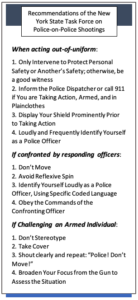Training and Safety: Potentially Lethal Blue-on-Blue Encounters
In 2010, a New York State Task Force was established to examine police-on-police shootings and to propose ways to reduce the frequency and danger of those high-risk confrontations. As a Task Force advisor, Dr. William Lewinski, Executive Director of the Force Science Institute, highlighted the behavioral science concepts that would foreseeably influence these officer-involved shootings.
Dr. Lewinski began by explaining how individuals use common patterns to interpret and predict the world. Learning how these “schemas” are subconsciously used in threat detection and use of force decisions, allowed the Task Force to appreciate how officers can honestly, but mistakenly, interpret the actions of armed plainclothes officers as threatening.
Dr. Lewinski’s report went on to detail predictable human responses under threat, including selective attention, “tunnel vision,” and inattentional blindness. With these insights, Task Force members questioned to what extent a visual sign, such as a badge, a “color of the day” armband, or even a familiar face, could reduce the risk of mistaken-identity shootings.
On May 27, 2010, the Task Force submitted its report, “Reducing Inherent Danger: Report of the New York State Task Force on Police-on-Police Shootings.”1 The response guidelines proposed by the Task Force were aimed at improving the safety of officers “taking action” out-of-uniform as well as the officers confronting them. (For your convenience, the Task Force recommendations are presented in the accompanying text box.)
In 2012, members of the Force Science Research Team built on the work of the 2010 Task Force by examining whether the training and experience of officers would align with the Task Force’s guideline recommendations.
The team, composed of Dawn A. O’Neill, William R. Spence, William J. Lewinski, and Emily J. Novak, began with a literature review that underscored the impact of environmental and perceptual considerations on guideline proposals. In other words, how would human factors such as pattern recognition, split attention, and visual cognition impact the Task Force recommendations.
Next, through an online survey of officers, the research team sought to answer two questions:
- What would surveyed officers identify as the critical actions for a plainclothes officer to take to ensure immediate proper identification and safety?
- What would surveyed officers identify as the critical commands for a responding officer to give to those who have identified themselves as plainclothes law enforcement officers?
Survey answers were derived from officers’ training and personal involvement in “blue-on-blue” incidents. The Force Science Team carefully analyzed the narrative answers for themes that were then categorized and compared to the 2010 Task Force recommendations.
Following the analysis, the research team concluded that there was still no consensus on what plainclothes officers should do to identify themselves, what actions the responding uniformed officers should be executing, or which commands responding officers should be giving. Notably, less than half of the surveyed officers had even received blue-on-blue training.
..there was still no consensus on what plainclothes officers should do to identify themselves, what actions the responding uniformed officers should be executing, or which commands responding officers should be giving.
Researchers further observed that best-practices to avoid “blue-on-blue” tragedies had yet to be empirically established and that too little is still known about the state of training for these high-risk events.
The findings of the Force Science Research team were an important next step in the fight to reduce police-on-police deadly force encounters. As the team considered future research to close the gaps in this vital area, this initial study, Training and Safety: Potentially Lethal Blue-on-Blue Encounters, was presented for publication in Police Practice and Research: An International Journal.
On April 8, 2019, Dr. Dilip K. Das Ph.D., founding Editor-in-Chief of the journal, notified the Force Science researchers that the peer review was complete, and the Force Science study was enthusiastically selected for publication.
Force Science News readers can expect a link to the full report and further analysis upon final publication. But for now, Congratulations to the Force Science Research team!
1 Stone, Christopher, Zachary Carter, Thomas Belfiore, Ella M. Bully-Cummings, Rev. Dr. Herbert Daughtry, Michael J. Farrell, . . . Damon T. Hewitt. “Reducing Inherent Danger: Report of the New York State Task Force on Police-on-Police Shootings.” New York State Task Force on Police-on-Police Shootings Report, May 27, 2010.



Congratulations team. Thank you for tour hard work keeping us safe. I believe the same rules for plain clothes officers will be true for armed civilians as well.
The complexity of processing so many bits of information, in a significantly compressed component of time, during a survival situation is phenomenal. Your continued work to dissect the physiological; psychological; intellectual; behavioral; cultural; experience and training impacts that all come together in making the decision at the moment aids your audience to reach a deeper, more complete level of comprehension. This topic requires continuous learning by so many stakeholders, researchers and the judicial system. Your information has helped me and those in my trusted circle. Keep the information coming and the practical research going!